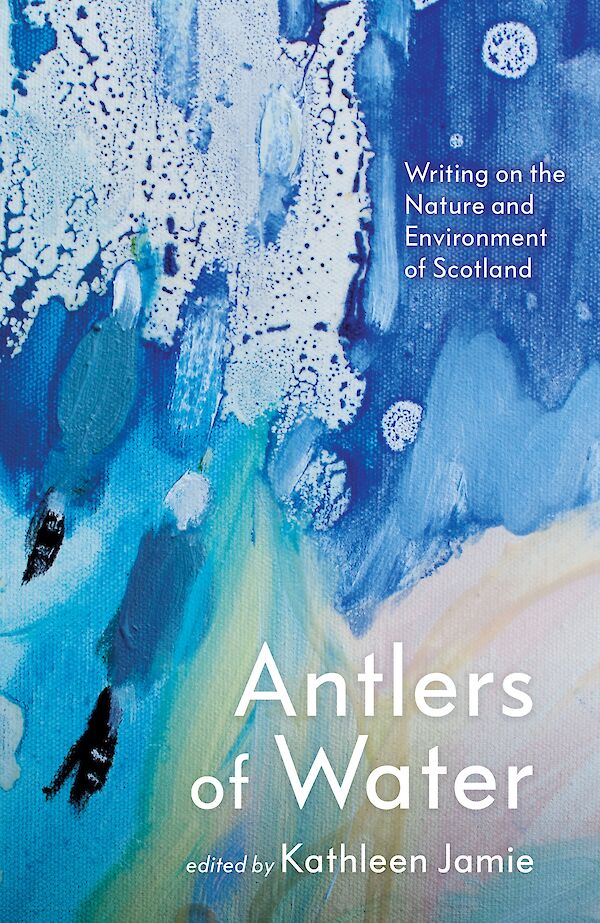Antlers of Water: Writing on the Nature and Environment of Scotland, edited by Kathleen Jamie, is our August Book of the Month. Blue Kirkhope reviews.

In Norman MacCaig’s ‘Looking Down On Glen Canisp’ poem from December of 1964, he writes of a peaceful hot summer’s day in Sutherland amongst the ‘scent of thyme and bog myrtle’, a still scene punctured by the presence of rutting stag. The poem concludes with the three words Antlers of Water, now 55 years later the title of a beautiful new anthology edited and curated by prolific Scottish poet and writer Kathleen Jamie.
My copy of the book is already creased around its edges from excited fumbling hands and it being carried around in my rucksack these past couple of weeks. These voices have accompanied me under the green canopy of woodland in Perthshire, basking in the afternoon heat by the riverbank in Dunkeld, on a trip across the coastal waters of the Firth of Clyde on a fisherman’s boat to the gannet-coated, granite islet of Ailsa Craig and amongst the glowing red sandstone buildings of my home city of Glasgow. Scotland and its landscapes are vitally important to me. This collection of writing proves that I am very much not alone.
It becomes apparent, page after page, that the climate and ecological emergency we are facing is unavoidable throughout the experiences of many of these writers. Whilst it is not always the main purpose of their writing, to dismiss its very existence would be to not acknowledge Scotland’s landscapes properly at all. ‘You will not see out ten years in this wood. Soon I’ll walk here with your absence’ Jim Carruth writes in his poem ‘Roe’, referring to the almost certain eventuality of loss of species — and in his later pieces, what has already been lost (such as the Arctic Lemming and the Northern Lynx). In Linda Cracknell’s ‘Lunar Cycling’ she closely inspects the barnacles clinging to an old pedal from a child’s bicycle, recovered from a coastline in Argyll and Bute. ‘It also spoke of nature’s way of using what we discard’ she says. Amanda Thomson’s island explorations consider the islander’s concern of rising sea levels on Uist, before Karine Polwart’s piece takes us northwards to Inge Thomson’s home of Fair Isle to discuss the effect human industry has on rising sea temperatures, which in turn is having a disastrous impact on sea life and has contributed to the devastating decline in seabird populations — particularly that of the darling kittiwake. Whilst there is of course beauty within these writings; of Scottish hills, beaches, cliffs and sea, there is certainly a profound acknowledgement of the climate crisis.
I am also infatuated with the pieces reflecting on pregnancy and motherhood. It is a comfort to read experiences in nature that don’t always require the “conquering” of a mountain. One of my favourite essays of the book is by a then seven-month pregnant Chitra Ramaswamy, who takes us on a coastal walk on the west coast of Scotland alongside her young son and describes her new-found perspective of these landscapes. ‘When you change your pace, particularly with a person even newer to the planet than you are, you see things all over again’. In the final essay of the book, ‘Swimming Away from My Baby’, we follow Amy Liptrot’s journey through pregnancy, learning how her relationship to the water changes as a new mother. Both of these pieces reiterate the importance of female bodies in these landscapes, but also that of preserving nature and safeguarding it for our children’s future, and their children’s future.
The nonsense modern concept of “wildness” and “escapism” throughout this anthology is almost refused — what we have here is a series of authentic experiences, each individual immersing themselves in nature, whether they are a person of colour, not physically able-bodied, or five months pregnant. There is absolutely no limitation to our relationship with the outdoors or anything associated with it. These pieces stand alone in their own right but are also interconnected on Scotland’s map; various eyes seeing something so different but very much the same. Antlers of Water is a warm invitation to reimagine your intimacy to nature, whether that’s within the confinements of a communal city garden or on an island surrounded by the vast ocean. But whilst we should enjoy it, in whatever manner we please, we must not forget we must also take care of it. As Jamie puts it, ‘the natural world is not here as a painted backdrop to our human concern: it is our human concern.’
*
Antlers of Water is out now, published by Canongate, and is available to buy here, priced £20.00. You can read an extract from the book — Jen Hadfield’s ‘I Da Welk Ebb’ — here.
Blue Kirkhope is a writer based in Glasgow with a keen interest in nature, birdlife and environmental sustainability. She has been exploring the many corners and peaks of her home soil in Scotland solo for many years, from the country’s southern borders to the northernmost point of Shetland. You can follow her on Twitter and Instagram.